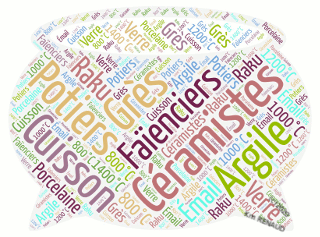Potter or ceramist:
Some explanations

Ceramist is the generic term for trades transforming clay by firing. This word was not used widely until the 19th century [1]. Formerly, the word potter replaced the word ceramist before the diffusion of this word. This may explain why the village of La Chapelle-des-Pots, which was once called "La Chapelle des Potiers" (litterally the Chapel of the Potters) was not called La Chapelle-des-Céramistes (litterally the Chapel of the Ceramists).
Overall, the potters of the past and the current ceramists are similar: they form, decorate, fire clay, but over time and the development of the industry these trades have been divided into specialties. Now, some only do form, spin, modeling, kilning, decorating, ...
Currently potter refers to a ceramist who manufactures pots, vases, plates, various containers or utensils,… rather in studio, workshop or small industry.
In addition, the word potter can designate in French the potter of tin [2] or the potter of clay, who does not make tiles or roof tiles like the tilemaker, bricks like the brick maker, French santons like ..., etc., but these different defined trades are part of the big family of ceramists, formerly called simply potters, especially in the days of French corporations.
Potter is one branch among the many specialties of the vast profession of ceramist.
To complicate these names, there are now several objects called ceramics although they are made without clay such as ceramic knives, some of which are only made of zirconium oxide, or silicon carbides also called ceramic. Some specify these ceramics as "technical ceramics" to differentiate them from "classic" clay-based ceramics, but these latter are also sometimes called technical ceramics when they are intended to constitute "technical" objects or machines.
There is no single definition of the word ceramic but they all have in common the fact of having undergone a high temperature firing which modified the mineralogical composition and the crystalline structures of the object during its firing to obtain new physicochemical properties, using pottery kilns used since the Neolithic and constantly improved since.
[1] Google Ngram Viewer. [online]. 2021. [Accessed 1 mai 2021]. Available at :
https://books.google.com/ngrams/graph?content=c%C3%A9ramique&year_start=1500&year_end=2019&corpus=30&smoothing=3&direct_url=t1%3B%2Cc%C3%A9ramique%3B%2Cc0#t1%3B%2Cc%C3%A9ramique%3B%2Cc0
[2] Potier d’étain : Fiche métier potier d’étain, métier de potier d’étain - INMA | Institut National des Métiers d’Art. [online]. 2021. [Accessed 1 mai 2021]. Available at :
https://www.institut-metiersdart.org/metiers-art/fiches-metiers/metal/potier-etain
To cite this page: Renaud, Kim. Potters or Ceramists: some explanations by Kim R. RENAUD, ATELIER RENÉ RENAUD [online]. mai 2021. [Accessed ../../20..]. Available at : http://atelier-rene-renaud.fr/Potters_or_ceramists.html